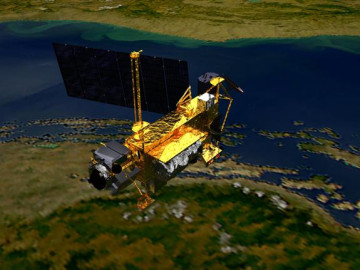NEW: Plummeting Satellite to Hit Earth Tomorrow Afternoon
Thursday, September 22, 2011
Heads up!
A 6 1/2 ton, defunct satellite has been in the midst of a death plunge from space, and the latest prediction by NASA's space junk experts is that it's going to plummet to Earth starting Friday afternoon.
And miss Rhode Island.
It's been a two-week guessing game as to exactly when and where the biggest piece of space junk to hit Earth's atmosphere in 10 years would plummet. The derelict Upper Atmosphere Research Satellite, or UARS, a 20-year-old spacecraft the size of a school bus, has given up the ghost and is expected to drop 26 pieces big enough to survive the Earth's incinerating reentry process and make it to terra firma.
Follow the falling satellite
You'd think that it'd be simple to compute the descent of an orbiting object, but not so. Factors like solar outbursts (which have been occurring recently) hasten the breakdown of orbits for low-flying spacecraft. Further, the satellite is tumbling, which leads to "unpredictable atmospheric-drag effects," much like the crazy bounce of a ball on an uneven turf. Finally, figure in the fact that the spacecraft has no fuel left for maneuvering, which adds a further element of unpredictability.
You're more likely to win PowerBall than be hit
What NASA does know, and hastens to inform, is that the odds of anyone actually being hit by any of these pieces are exceedingly low. NASA's Orbital Debris Program Office has estimated that the chances that any UARS debris would hit anyone were 1 in 3,200... which translates into a 1-in-20 trillion risk for any one person.
For those lucky enough to see these piece reenter tomorrow (and lucky enough not be be hit as they do), those chunks will look like a bright red streak crossing the sky. Some of those pieces could weigh as much as 300 pounds as they singe and hurtle toward Earth.
Like all things astronomical, UARS has fired up Rhode Island's collective imagination. Astonomy just seems to hit that sweet spot between technology and imagination, says Ian Dell'Antonio, associate professor of physics at Brown University, which houses the popular Ladd Observatory. "There's a healthy amateur astronomy community in Rhode Island," says Dell'Antonio, "and in a little state with a lot of light and a lot of clouds." Dell'Antonio reminds that there are far more articles in the New York Times about astronomy than there are astronomers. "It just captures the imagination," he says. "And the pretty pictures don't hurt."
Other space crashers
The last major space-based incursion was in March 2001, when Mir, the Soviet/Russian space station, made a controlled reentry to Earth. Before that, Skylab's 69,000 kg of space junk made a memorable, uncontrolled plummet to Earth. (For a chart of the largest objects to reenter, go here).
Keep an eye on things
There are lots of great places for space junk junkies to keep track of UARS as it makes its descent. NASA and its partners at US Strategic Command will be issuing updates beginning 24 hours from the expected fall, then T-minus-12 hours, T-minus 6, and so on. One great source for updates is the Center for Orbital and Reentry Studies, here; another is www.n2yo.com.
Twitter fans might enjoy following UARS' plummet Twitter-feed (not an official NASA site).
And for a cool digital modeling of what we've got in store, check out this video from Analytical Graphics.
Related Articles
- NEW: Perseid Meteor Shower Starts Tonight
- NEW: Largest Full Moon in 18 Years To Rise Over Rhode Island Tonight



